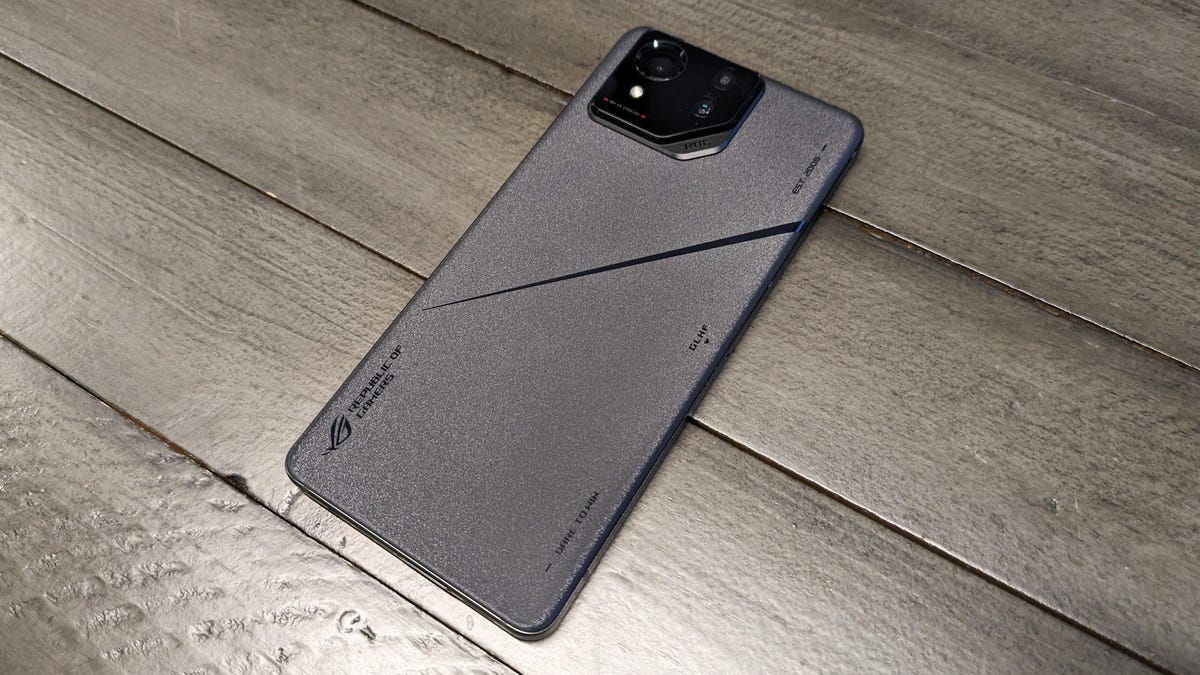Asus has given its ROG gaming phone line a redesign that keeps its focus on games while also improving general phone function. Announced Monday at CES 2024, the Asus ROG Phone 8 and Phone 8 Pro are powered by the new Qualcomm Snapdragon 8 Gen 3 chip. They pack a 6.78-inch display with a refresh rate as high as 165Hz and — in the Pro edition — specs as high as 24GB of memory and 1TB of storage. In a first for Asus’ gaming phone line, the Phone 8 series includes wireless charging and IP68 resistance to water and dust.
The phones now adopt a punch-hole front-facing camera style, which eliminates the large top bezel that hid the front-facing camera in prior ROG phones. While this does mean games played at full screen will now have a small interruption of space around the punch-hole, Asus also gives you the option to slightly shrink the display area to avoid the front-facing camera. This differs from rival RedMagic’s strategy of including its selfie camera underneath the display for an uninterrupted full screen, but that approach often comes at the cost of image quality for photos.
The ROG Phone 8 takes advantage of its AI-focused Qualcomm Snapdragon 8 Gen 3 to enhance a number of features about the phone part of this gaming phone. The Semantic Search processes anything entered into the launcher, device settings or photo gallery search boxes on the device in order to return results. For voice and video calls, the ROG Phone 8 includes an AI noise-canceling feature that Asus says will work in both standard calls and in-game chat. You can use AI to generate a phone wallpaper from selected objects, tones and other backgrounds.

Read more: The Most Eye-Catching Mobile Tech at CES 2024
Asus has also revamped its cameras, primarily a 50-megapixel main camera that’s supported by a stabilizer — Asus calls it the 6-Axis Hybrid Gimbal Stabilizer 3.0 — for smoothing out videos along with photos. The main camera is joined by a 13-megapixel ultrawide camera and a 32-megapixel telephoto lens with a 3x optical zoom. On the front, a 32-megapixel selfie camera is now included within the device display.

While the ROG Phone 8 series now includes IP68 water resistance, that also means that the phone itself has had to change up its cooling system for heat exhaust. Asus says the Phone 8 now uses conduction cooling to send heat from the internals to the phone’s back cover. Asus is also releasing a new AeroActive Cooler X attachment for enhancing cooling, but it will no longer open a door in the back of the phone for that purpose as last year’s ROG Phone 7 Ultimate did.

The Pro model also changes the rear display on the back of the phone from a full-color screen into a mini-LED display, similar to the small rear screen on the Asus ROG Phone 6 Pro. Asus dubs this display as AniMe Vision, and it can be set to provide contextual animations. Instead of the mini-LED display, the standard Phone 8 models get an RGB-lit logo.
The Phone 8 series retains its predecessor’s 65-watt wired charging and now includes a slightly smaller capacity 5,500 mAh battery compared with the Phone 7’s 6,000 mAh battery. The 15-watt wireless charging is new, but it doesn’t include the new Qi2 standard. Wi-Fi 7 support is included, the phone still includes two USB-C ports, and the headphone jack still lives on Asus’ gaming phone line.

The Asus ROG Phone 8 starts at $1,100 for a model that includes 16GB of memory and 256GB of storage, while the Pro model starts at $1,200 for 16GB of memory and 512GB of storage. The highest-end Pro model that includes 24GB of memory and 1TB of storage goes for $1,500 and throws in the AeroActive Cooler X. Otherwise the cooler attachment costs $100. The phones will be released in the first quarter of 2024, and during an early bird period will be sold at a $100 discount.
Originally published Jan. 8, 2024 at 4 p.m. PT.



